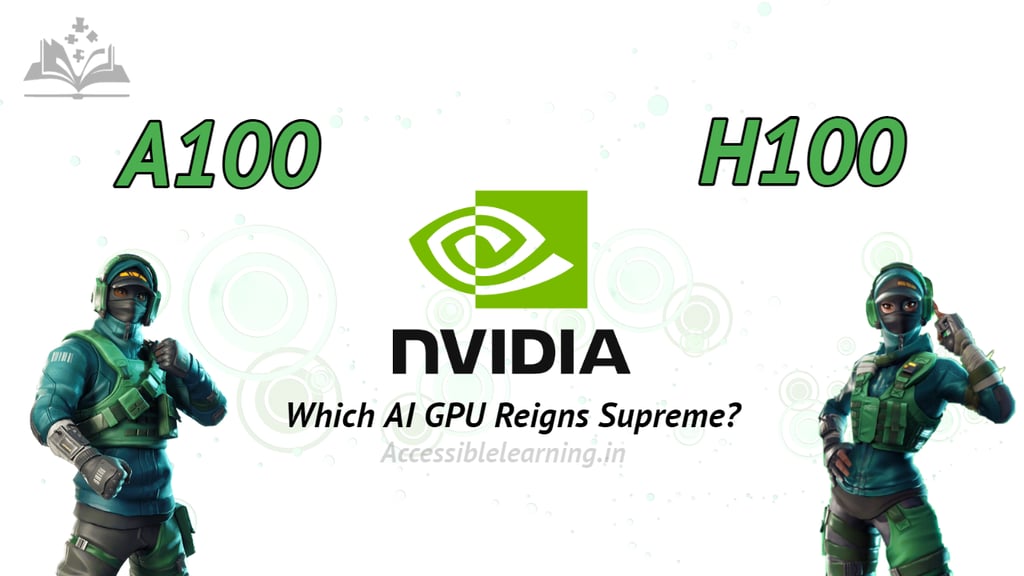
Nvidia A100 and H100 Explained: Which AI GPU Reigns Supreme?
Learn the key differences between Nvidia's A100 and H100 GPUs in this in-depth comparison. Learn how these cutting-edge technologies power the advancement of AI and machine learning, from the versatile A100 with Ampere architecture to the revolutionary H100 with Hopper enhancements. Whether you're looking for flexibility or raw performance, this guide will help you choose the right GPU for your AI project.
AI ASSISTANTA LEARNINGCOMPANY/INDUSTRYAI/FUTUREAI ART TOOLS
Sachin K Chaurasiya
10/22/20243 min read


In the fast-moving world of artificial intelligence, Nvidia has emerged as a leader in developing the hardware needed to fuel AI research and applications. Two of its most notable contributions to AI computing are the Nvidia A100 and H100 GPUs. These GPUs are designed to push the boundaries of machine learning, deep learning, and AI-powered applications, but how are they different, and what makes them so powerful?
Nvidia A100: A Game Changer in AI Computing!
Launched: May 2020
Architecture: Ampere
Memory: 40 GB and 80 GB HBM2e options
Performance: Up to 19.5 teraflops (FP32)
Purpose: AI, high-performance computing (HPC), and data analytics
The Nvidia A100 is built on the Ampere architecture, which is a significant leap from its predecessor, the Volta architecture. Its main strength lies in the Tensor Cores, which are optimized to speed up deep learning tasks. These cores can perform multi-precision operations, including FP16, FP32, INT8, and even FP64 for more complex calculations.
A special feature of the A100 is its Multi-Instance GPU (MIG) technology. With MIG, the A100 can be split into seven smaller GPUs, each capable of running separate tasks. This ensures that even small workloads can fully utilize the power of the A100, making it highly efficient in data centers where workload flexibility is crucial.
In terms of AI applications, the A100 significantly accelerates the training and inference of machine learning models, making it a favorite for researchers and businesses diving into AI-driven innovations.
Nvidia H100: A Leap Toward the Future!
Launched: March 2022
Architecture: Hopper
Memory: 80 GB HBM3
Performance: Up to 60 teraflops (FP32)
Purpose: Large-scale AI training, HPC, and data analytics
The Nvidia H100 is built on the Hopper architecture, which further improves the AI capabilities introduced with the A100. The most impressive jump in performance comes from switching to HBM3 memory, which allows for higher bandwidth and faster data access compared to the A100's HBM2e. This makes the H100 perfect for large-scale AI models that require processing very high volumes of data.
The H100 also introduces the Transformer Engine, a feature specifically designed to accelerate the training of transformer-based models, which are the backbone of modern natural language processing (NLP) and computer vision tasks. This optimization means that models such as GPT, BERT, and other transformers can be trained more efficiently and with greater accuracy on the H100.
Additionally, the H100 has FP8 precision support, which enables faster calculations while maintaining the accuracy needed for advanced AI tasks. This level of customization is crucial for companies working on cutting-edge AI models, where speed and accuracy are paramount.


Key Differences Between A100 and H100!
Architecture: The A100 is based on Ampere, while the H100 uses the Hopper architecture. The Hopper architecture brings advanced optimizations, especially for Transformer models.
Performance: While the A100 can achieve up to 19.5 teraflops (FP32), the H100 surpasses it with up to 60 teraflops, making it more powerful for computationally intensive AI tasks.
Memory: The A100 comes with 40 GB or 80 GB of HBM2e memory, while the H100 has 80 GB of HBM3 memory, providing faster data throughput.
Precision Support: The A100 supports FP64, FP32, and FP16, while the H100 offers FP8, which further improves performance in certain AI workloads.
Target applications: The A100 is still a powerhouse for general-purpose AI workloads, while the H100 is more specialized for cutting-edge research, large-scale training, and transformers, where speed and efficiency are even more important.
Which One is Right for You?
If you're working on cutting-edge AI research or deploying AI at scale, the Nvidia H100 is the clear choice due to its superior performance, memory bandwidth, and optimizations for Transformer models. It's built for the future of AI, where tasks like training large language models or complex simulations require every bit of available computing power.
On the other hand, if your focus is more on flexibility and multi-tenant environments where smaller workloads need to be handled alongside larger workloads, the A100's MIG feature and excellent overall performance still make it a highly viable option. The A100 remains a popular choice for data centers and businesses that need a balance between performance and efficiency.
Nvidia's A100 and H100 are two of the most powerful GPUs available for AI and machine learning applications today. While the A100 revolutionized AI computing with its Ampere architecture, the H100 takes it a step further with the Hopper architecture, which delivers next-level performance and optimization for AI training, especially in large-scale environments. Both GPUs are essential tools for anyone who wants to harness the power of AI and push the boundaries of what's possible in computing.
In choosing either of the two, it all depends on your specific needs—whether that's flexibility and versatility with the A100 or raw power and future-focused performance with the H100. Either way, Nvidia is continuing to pave the way for innovations in AI, ensuring that both researchers and businesses have the tools they need to thrive in the age of intelligence.
Subscribe to our newsletter
All © Copyright reserved by Accessible-Learning
| Terms & Conditions
Knowledge is power. Learn with Us. 📚


